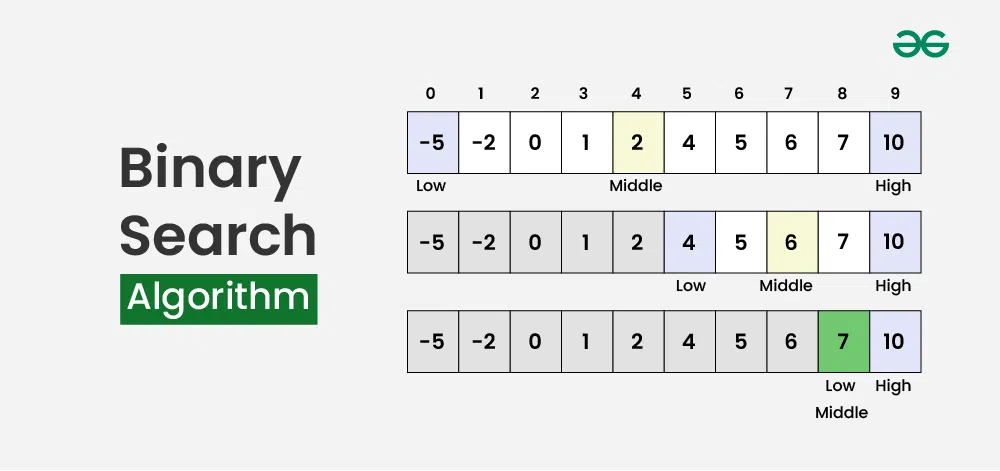Binary Search (Geeks for Geeks)
What is Binary Search?
Binary Search is a highly efficient search algorithm used to find the position of a target element within a sorted list. It works by repeatedly dividing the search interval in half and comparing the target value to the middle element of the interval.
Algorithm for Binary Search
- Start with the left pointer at the beginning of the list and the right pointer at the end.
- Calculate the middle index of the current search interval.
- Compare the target value with the middle element:
- If the target value equals the middle element, return the middle index.
- If the target value is less than the middle element, move the right pointer to .
- If the target value is greater than the middle element, move the left pointer to .
- Repeat steps 2-3 until the left pointer exceeds the right pointer.
- If the target value is not found, return -1.
How does Binary Search work?
- It starts by comparing the target value to the middle element of the list.
- If the target value matches the middle element, the search is complete.
- If the target value is less than the middle element, the search continues in the left half of the list.
- If the target value is greater than the middle element, the search continues in the right half of the list.
- This process continues until the target value is found or the search interval is empty.

Problem Description
Given a sorted list and a target element, implement the Binary Search algorithm to find the index of the target element in the list. If the element is not present, return -1.
Examples
Example 1:
Input:
list = [1, 3, 5, 7, 9]
target = 5
Output: 2
Example 2:
Input:
list = [2, 4, 6, 8, 10]
target = 7
Output: -1
Your Task:
You dont need to read input or print anything. Complete the function binarysearch() which takes arr[], N and K as input parameters and returns the index of K in the array. If K is not present in the array, return -1.
Expected Time Complexity: Expected Auxiliary Space: if solving recursively and O(1) otherwise.
Constraints
Implementation
- Python
- C++
- Java
- JavaScript
def binary_search(lst, target):
left, right = 0, len(lst) - 1
while left <= right:
mid = left + (right - left) // 2
if lst[mid] == target:
return mid
elif lst[mid] < target:
left = mid + 1
else:
right = mid - 1
return -1
#include <iostream>
#include <vector>
int binary_search(const std::vector<int>& lst, int target) {
int left = 0, right = lst.size() - 1;
while (left <= right) {
int mid = left + (right - left) / 2;
if (lst[mid] == target) {
return mid;
} else if (lst[mid] < target) {
left = mid + 1;
} else {
right = mid - 1;
}
}
return -1;
}
int main() {
std::vector<int> lst = {1, 3, 5, 7, 9};
int target = 5;
std::cout << "Index: " << binary_search(lst, target) << std::endl;
return 0;
}
public class BinarySearch {
public static int binarySearch(int[] lst, int target) {
int left = 0, right = lst.length - 1;
while (left <= right) {
int mid = left + (right - left) / 2;
if (lst[mid] == target) {
return mid;
} else if (lst[mid] < target) {
left = mid + 1;
} else {
right = mid - 1;
}
}
return -1;
}
public static void main(String[] args) {
int[] lst = {1, 3, 5, 7, 9};
int target = 5;
System.out.println("Index: " + binarySearch(lst, target));
}
}
function binarySearch(lst, target) {
let left = 0, right = lst.length - 1;
while (left <= right) {
const mid = left + Math.floor((right - left) / 2);
if (lst[mid] === target) {
return mid;
} else if (lst[mid] < target) {
left = mid + 1;
} else {
right = mid - 1;
}
}
return -1;
}
const lst = [1, 3, 5, 7, 9];
const target = 5;
console.log("Index:", binarySearch(lst, target));
Complexity Analysis
- Time Complexity: , where is the number of elements in the list. The list is divided in half at each step, leading to logarithmic time complexity.
- Space Complexity: , as no extra space is required apart from the input list.
Advantages and Disadvantages
Advantages:
- Highly efficient for large sorted lists.
- Fast search time due to logarithmic time complexity.
Disadvantages:
- Requires the list to be sorted.
- Less efficient for small lists compared to linear search.
References
- GFG Problem: GFG Problem
- HackerRank Problem: HackerRank
- Author's Geeks for Geeks Profile: MuraliDharan